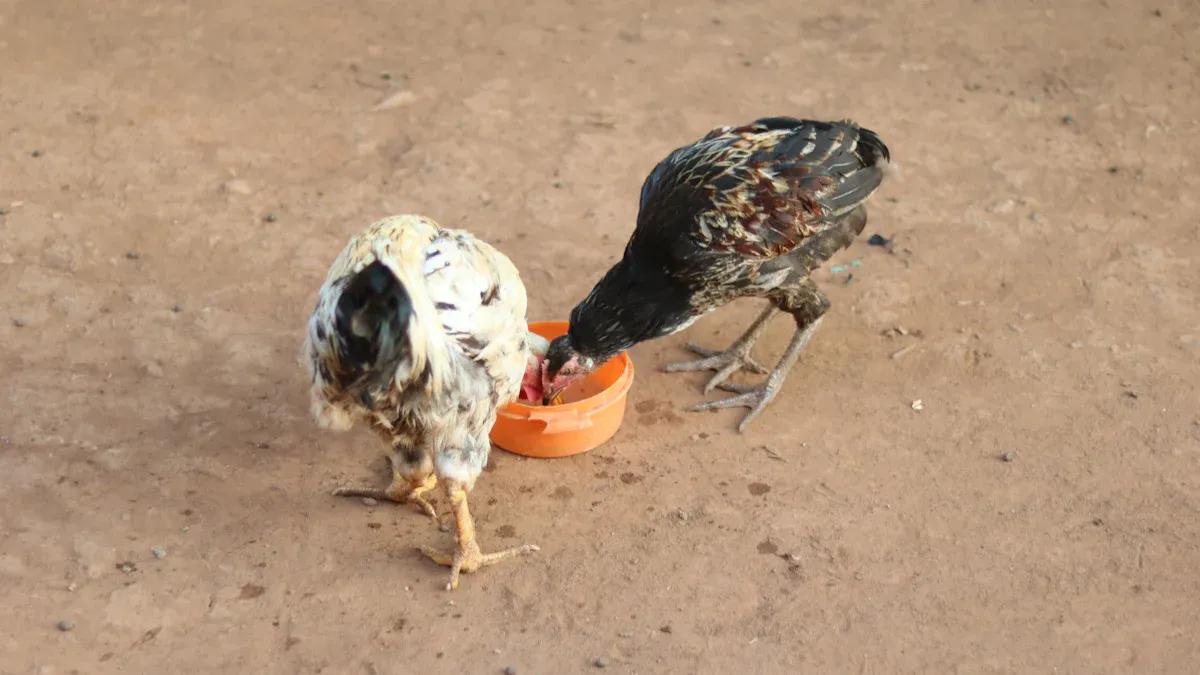
Farmers worldwide choose organic mealworms for chickens to deliver superior protein and boost flock health. Scientific studies show mealworm protein levels often exceed 47%, supporting growth and sustainability. 🐥 Europe leads the market, reflecting strong adoption.

Key Takeaways
- Organic mealworms provide high-quality protein, healthy fats, and essential nutrients that help chickens grow faster, stay healthier, and produce better eggs.
- Adding mealworms to poultry feed improves gut health and immune function, reducing disease risks and supporting natural behaviors for a happier flock.
- Using mealworms in feed lowers environmental impact by saving land, water, and energy, making poultry farming more sustainable and cost-effective.
Nutritional Profile of Organic Mealworms for Chickens

Protein Content and Amino Acid Balance
Organic mealworms for chickens deliver a powerful protein punch. Their protein content ranges from 36.3% to 74.1% on a dry matter basis, which often surpasses traditional feed ingredients. Chickens need a variety of amino acids for muscle growth, feather development, and egg production. Mealworms supply 14 amino acids, including essential ones like leucine, glycine, and aspartic acid. This rich amino acid profile helps chickens grow stronger and healthier.
Farmers who add mealworms to their feed see better flock performance and improved egg quality.
Healthy Fats and Energy Value
Mealworms contain about 25% healthy fats, making them an excellent energy source for poultry. These fats support active chickens, shiny feathers, and overall vitality. The fat content in mealworms increases as they mature, providing even more energy when needed most. Mealworms also offer B vitamins that help chickens turn food into energy, keeping them lively and productive.
| Nutrient | Quantity/Description |
|---|---|
| Fat Content | ~25% of mealworm composition |
| Protein | ~50% (contextual for balance with fat) |
| Fiber | ~7% |
Essential Vitamins and Minerals
Mealworms supply vital minerals such as calcium, phosphorus, iron, manganese, and zinc. These nutrients support strong bones, healthy eggshells, and robust immune systems. For example, calcium levels can reach up to 79 mg per 100 g, which helps meet poultry nutrition standards. Mealworms also contain magnesium, potassium, sodium, and copper, all important for chicken health. By adjusting their diet, producers can enhance the mineral content of mealworms to match specific flock needs.
Adding mealworms to poultry feed not only boosts nutrition but also encourages natural foraging, making chickens happier and healthier.
Health Benefits of Organic Mealworms for Chickens
Enhanced Growth and Feed Conversion
Chickens need high-quality protein and balanced nutrients to grow quickly and efficiently. Organic mealworms for chickens provide a rich source of protein, healthy fats, and essential amino acids. Studies show that when farmers replace traditional protein sources like soybean meal with mealworm meal, chickens grow faster and reach better slaughter weights. Researchers found that including mealworms in the diet can improve feed conversion ratios, especially during the starter period. This means chickens gain more weight from the same amount of feed, which saves money and resources for poultry producers.
Mealworm meal supports strong growth and efficient feed use, making it a smart choice for modern poultry farms.
Mealworms also contain chitin, a natural compound that acts as a prebiotic. Chitin helps chickens absorb nutrients better and supports healthy digestion. Controlled studies reveal that low levels of mealworm inclusion (up to 7.5%) do not harm gut health and may even improve it. Chickens fed with mealworm meal often show higher daily weight gains and improved body condition.
Immune System Support
A strong immune system keeps chickens healthy and reduces the need for medications. Mealworms offer unique benefits for immune support. They contain chitin and antimicrobial peptides, which help chickens fight off harmful bacteria and viruses. These nutrients strengthen the intestinal barrier and promote a healthy gut microbiome. Scientific research highlights that mealworm nutrients can boost mucin production, which forms a protective layer in the gut and blocks pathogens.
- Mealworms provide zinc, magnesium, vitamin B12, and other B vitamins. These nutrients are vital for immune function.
- Chickens with better immune systems resist diseases more effectively and recover faster from stress.
Farmers notice that chickens fed with mealworms stay healthier and require fewer treatments. This supports organic and sustainable poultry practices.
Improved Gut Health and Feather Quality
Gut health plays a key role in chicken well-being and productivity. Mealworms help maintain a balanced gut microbiota, which improves digestion and nutrient absorption. Studies show that mealworm supplementation reduces harmful bacteria like E. coli and Salmonella in the digestive tract. Chickens eating mealworms often have healthier intestines, with increased villus height and crypt depth, which means better nutrient uptake.
- Mealworms encourage natural foraging behavior, which lowers stress and supports overall health.
- Chitin in mealworms promotes beneficial bacteria and suppresses pathogens in the gut.
While direct links between mealworm consumption and feather quality are limited, improved nutrition and gut health often lead to shinier feathers and better appearance. Healthy feathers protect chickens from weather and injury, making them more comfortable and productive.
By adding mealworms to poultry diets, farmers can boost gut health, support immune function, and encourage natural behaviors—all leading to a happier, healthier flock.
Organic Mealworms for Chickens vs. Traditional Protein Sources
Digestibility and Bioavailability
Chickens need protein that their bodies can easily use. Organic mealworms for chickens offer high protein digestibility. Studies in animals like rabbits and pigs show that mealworm protein is easier to digest than soybean meal or fish meal. In poultry, research with quails found that mealworms support good digestion, especially for fats. Chickens can break down the chitin in mealworms, which helps them absorb more nutrients. This means chickens get more value from every bite.
Sustainability and Environmental Impact
Farmers today care about the planet as much as their flocks. Organic mealworms use less land and water than soy or fish meal. They also produce fewer greenhouse gases. Mealworm farming needs less space because it uses vertical stacking. Mealworms eat by-products like wheat bran, which reduces waste. Compared to broiler protein, mealworms emit 23% less greenhouse gases and use 18% less non-renewable energy. They require 70% less land and cause 72% less acidification. The only area where mealworms have a slight increase is freshwater eutrophication, but the overall impact remains much lower.
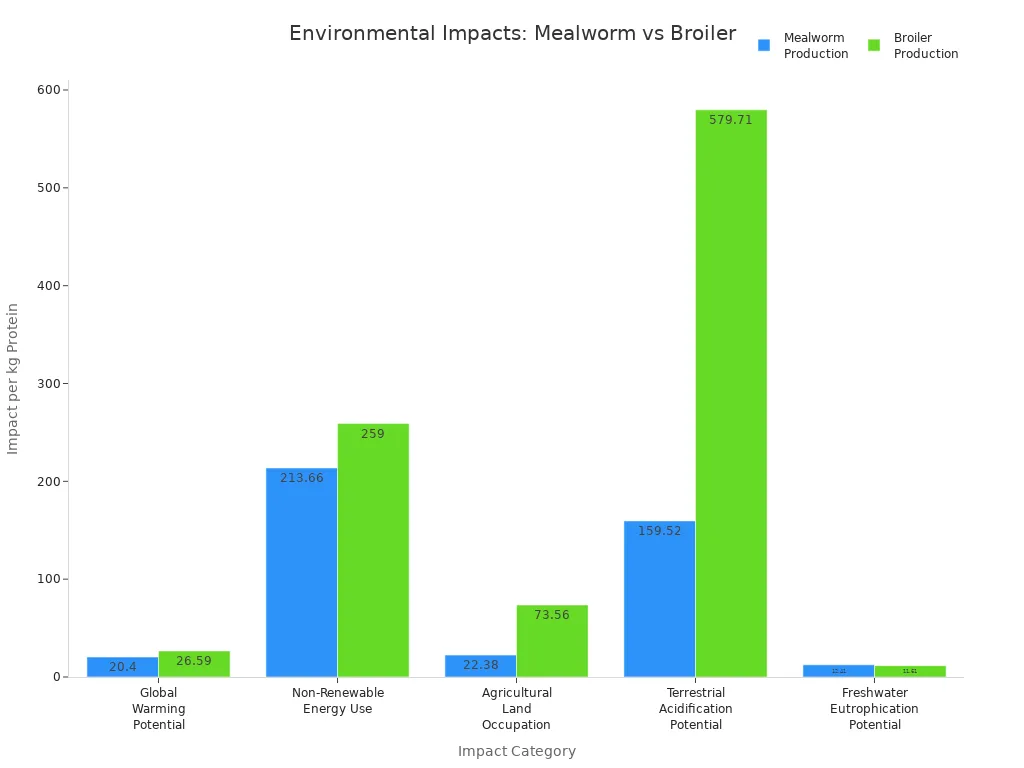
Choosing mealworms helps poultry producers lower their environmental footprint and support a greener future.
Nutritional Consistency and Quality
Mealworms deliver a complete amino acid profile, including methionine and glycine, which are often missing in plant-based feeds. They also provide healthy fats, fiber, and vitamins like B12. The table below shows how mealworms compare to other protein sources:
| Protein Source | Protein Content (%) | Amino Acid Profile | Additional Nutrients | Calcium Content | Sustainability Notes |
|---|---|---|---|---|---|
| Organic Mealworms | 51.93% to 65% | Complete; includes methionine, glycine, proline | Healthy fats, fiber, vitamins (B12), phosphorus | Low calcium | Use less land & water, fewer emissions than soy/fish |
| Soy Meal | ~44.51% | Lacks some essential amino acids like methionine | Plant-based, less complete protein | N/A | High water use, deforestation, higher emissions |
| Fish Meal | ~62.6% | High protein, complete amino acids | Rich protein source | N/A | Overfishing concerns, habitat destruction |
| Black Soldier Fly Larvae (BSFL) | ~48% | Good protein, optimal calcium to phosphorus ratio | Higher calcium than mealworms | High calcium | Efficient farming on organic waste |
Mealworms should be used as a supplement, not the main feed. When added in moderation, they boost growth, feather quality, and egg production. Their nutritional consistency makes them a reliable choice for modern poultry diets.
Practical Inclusion of Organic Mealworms in Feed Formulations
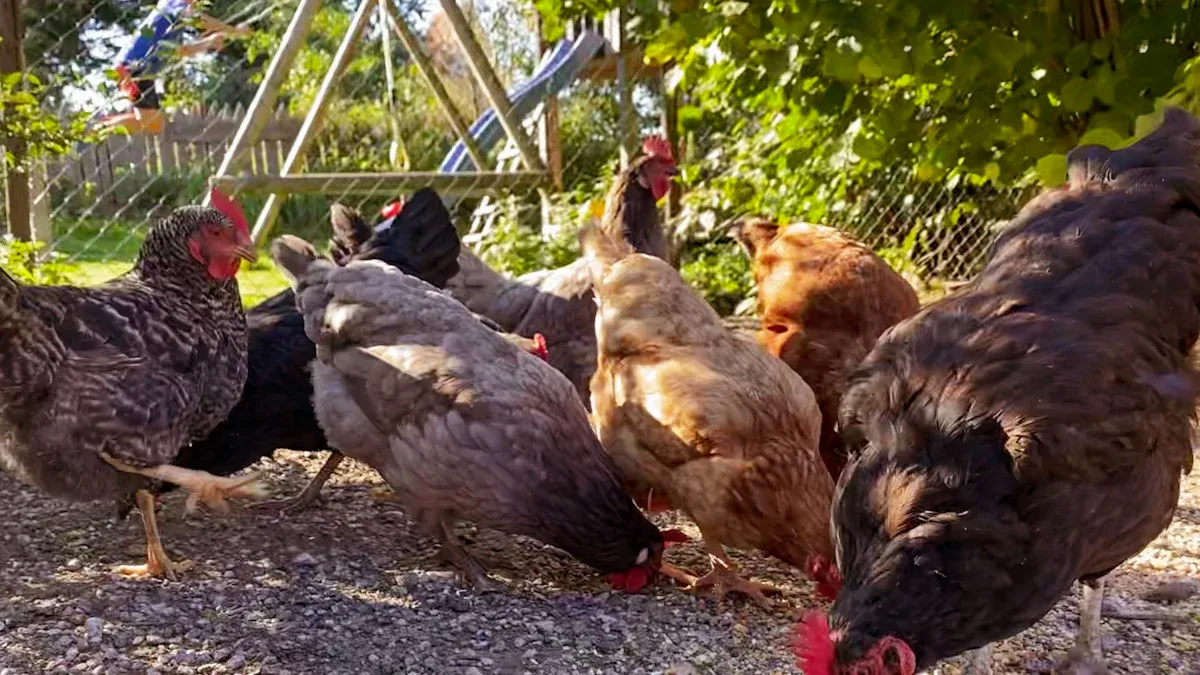
Recommended Inclusion Rates and Feeding Guidelines
Poultry producers can confidently add organic mealworms for chickens to their feed at rates between 2% and 5%. Scientific trials show that these levels support healthy growth, strong immune systems, and stable gut health in both laying hens and broilers. Including mealworm meal at 2.5% to 5% in broiler diets improves weight gain, feed conversion, and disease resistance. The table below highlights the effects of different inclusion rates:
| Parameter / Inclusion Level | Details / Effects |
|---|---|
| 2.5% Mealworm Meal | Improved early weight gain, better immune response |
| 4% Mealworm Meal | Higher body weight, improved feed efficiency |
| 5% Mealworm Meal | Reduced harmful gut bacteria, enhanced health |
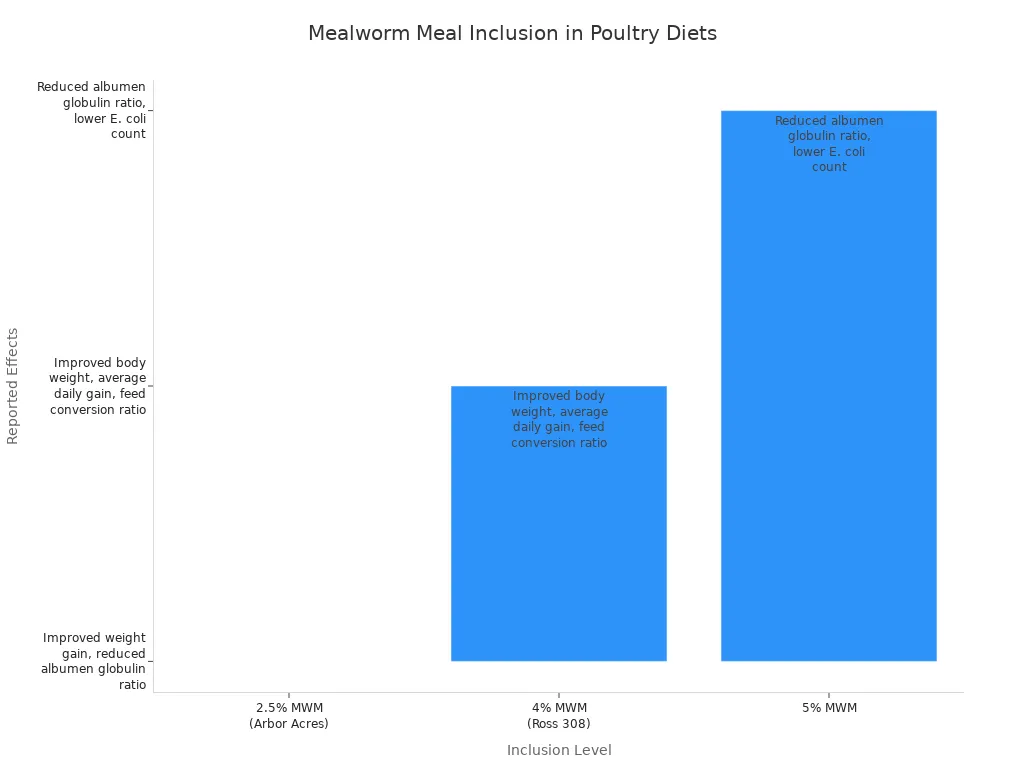
Producers should introduce mealworms gradually and always provide a balanced diet for best results.
Processing and Preparation Methods
Maintaining the nutritional value of mealworms requires careful processing. Gentle drying methods, such as infrared or microwave drying, help preserve protein and antioxidant activity. Controlled cooking reduces harmful microbes while keeping nutrients intact. High hydrostatic pressure and non-thermal pre-treatments also protect protein quality. These methods ensure that chickens receive the full benefits of mealworm nutrition in every bite.
- Infrared drying with pulsed electric field pre-treatment keeps proteins stable.
- Microwave drying offers a fast and effective way to retain color and nutrients.
- Controlled cooking lowers bacteria without losing key vitamins and minerals.
Integration with Other Feed Ingredients
Mealworms work best when combined with other quality feed ingredients. Producers can boost protein content by pairing mealworms with chickpea or barley bran. Adding corn bran or potato waste supports energy needs and improves feed conversion. Since mealworms have low calcium, mixing them with calcium-rich feeds ensures strong eggshells and healthy bones. By blending mealworm meal with balanced grains and minerals, poultry diets become more complete and effective.
Smart integration of mealworms with other ingredients leads to healthier, more productive flocks.
Economic and Sustainability Considerations of Organic Mealworms for Chickens
Cost-Effectiveness for Poultry Producers
Producers look for feed solutions that balance cost and value. Recent cost-benefit analyses compare circular insect meal production with traditional feed models. These studies use real-world data from companies in Europe and follow strict economic guidelines. Key findings include:
- Circular models show higher costs at small scales due to investment and operations.
- Upscaling and new technology can lower costs and improve profits over time.
- Mealworm production uses less land and creates fewer emissions than livestock, which can lead to long-term savings.
Producers who invest in mealworm-based feed may see better returns as the industry grows and technology advances.
Environmental Benefits and Waste Reduction
Mealworm farming stands out for its positive impact on the environment. Farmers use mealworms to turn low-value by-products, like wheat bran and brewer’s grain, into high-protein feed. This process reduces waste and supports a circular economy. Mealworms also:
- Use less water and land than traditional livestock.
- Produce frass, a natural fertilizer that replaces synthetic options.
- Help recycle nutrients and cut down on greenhouse gas emissions.
A table below shows how mealworms convert wine pomace into valuable protein and fertilizer:
| Waste Type | Protein Yield (%) | Nitrogen Change | Carbon Change | Frass Value |
|---|---|---|---|---|
| Red Wine Pomace | Up to 73 | +2.85% | -6.2% | High in Nitrogen |
Mealworm farming turns waste into resources, making poultry feed more sustainable.
Market Trends and Consumer Preferences
The poultry feed market is changing fast. More producers choose mealworm-based feeds because consumers want healthier and more sustainable products. Key trends include:
- Growth in North America, Europe, and Asia-Pacific due to strong demand and government support.
- Rising popularity of organic and sustainable feed options.
- Consumers pay more for poultry raised on eco-friendly diets and value transparency in production.
Research shows that people prefer poultry products from ethical and sustainable sources. Regulatory approvals for insect protein in feed also boost market confidence. Producers who use mealworm-based feeds meet both market demand and consumer expectations.
Mealworms deliver stable protein (49.1%) and lipid (38.3%) content, supporting strong growth and immune health in poultry.
| Nutritional/Health Aspect | Evidence Summary |
|---|---|
| Growth Performance | Mealworms match or surpass fish/soybean meal for growth and digestibility. |
| Immune Response | Mealworms reduce harmful bacteria and boost immunity. |
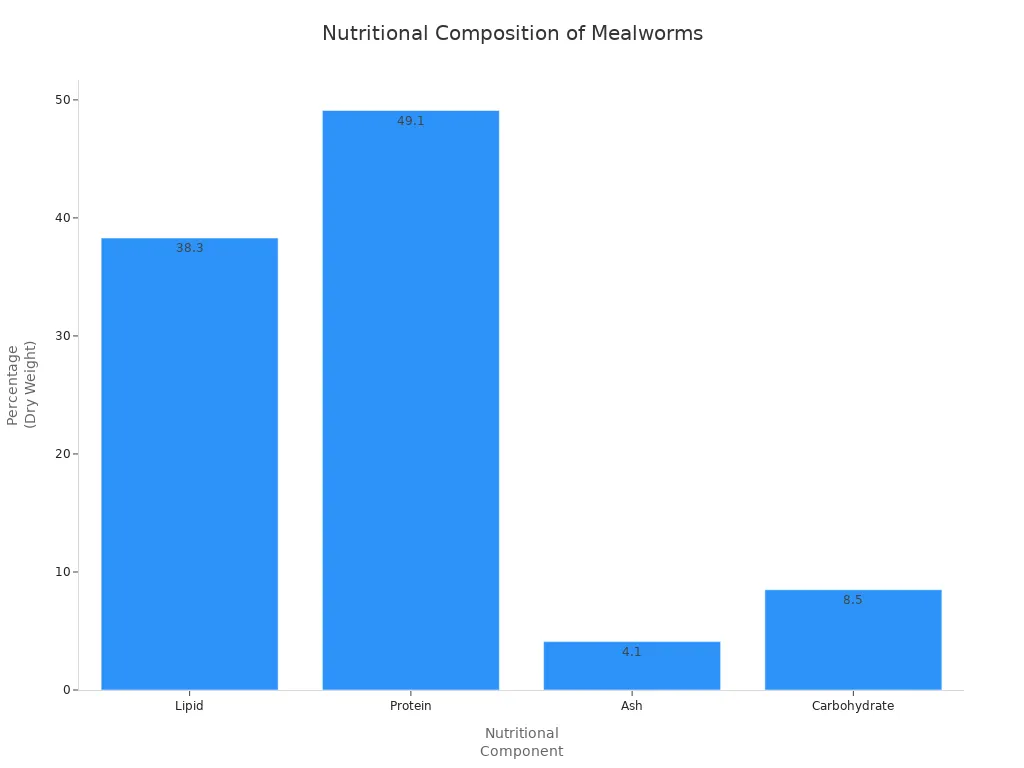
Producers should adopt mealworms for sustainable, cost-effective feed innovation.
FAQ
Can chickens eat organic mealworms every day?
Chickens can enjoy organic mealworms daily as a supplement. Producers should offer them in moderation to maintain a balanced diet and support optimal flock health.
Do organic mealworms improve egg quality?
Yes! Organic mealworms provide protein and nutrients that help hens lay eggs with stronger shells and richer yolks. Farmers often see better egg production after adding mealworms.
How should farmers introduce mealworms into poultry feed?
Farmers should start with small amounts. Gradually increase the portion to recommended levels. This approach helps chickens adjust and ensures the best nutritional benefits.
Tip: Scatter mealworms to encourage natural foraging and keep chickens active! 🐔


